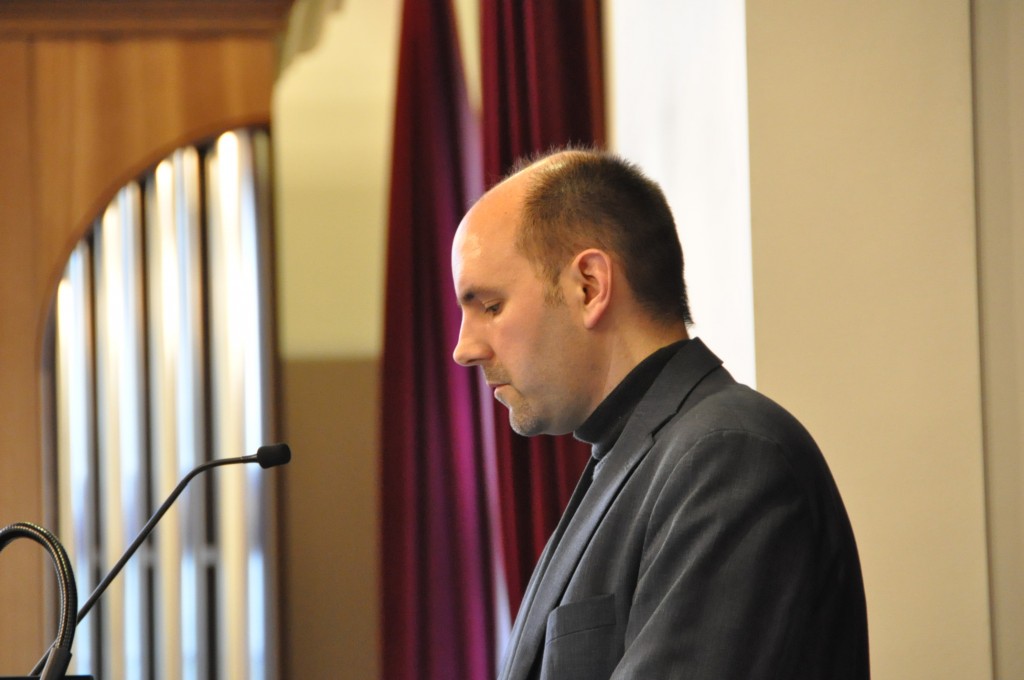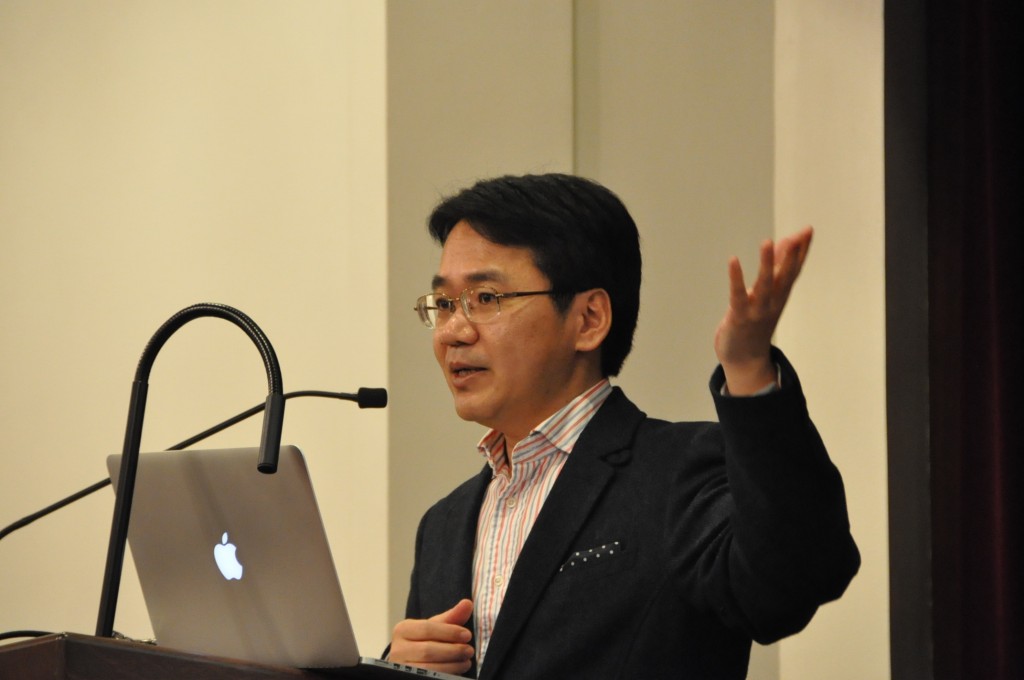Center for Interdisciplinary Study of Monotheistic Religions(CISMOR)Doshisha University
> Public Lectures > Cultural Comparison on Animals and Specters: Between Japanese and Monotheistic CulturesPublic Lectures
Public Lecture with Tuebingen Center for Japanese Studies
Cultural Comparison on Animals and Specters: Between Japanese and Monotheistic Cultures
| Date: |
2015/01/29 16:00-18:00 |
|---|---|
| Place: | Clarke Memorial Hall Chapel, Imadegawa Campus, Doshisha University |
| Lecture: |
Prof. Michael Wachutka, Director, Tuebingen Center for Japanese Studies Prof.Katsuhiro Kohara, Director, CISMOR |
| Summary: | |
|
Prof. Watchutka presented first and stated that in contemporary Japanese discourse, yōkai was an umbrella term that expresses various mystical phenomena. Since ancient times, both unexplainable phenomena and mystical living entities have appeared in Japan’s religious and secular discourses. However, until the Kamakura period, people who were threatened by them or the ability to suppress the supernatural were emphasized, rather than yōkai. During the Edo period, Wakan sansai zukai and other texts appeared as part of an encyclopedic (taxonomic) discourse. On the other hand, hyaku monogatari kaidankai (events at which scary stories were told at night) gained popularity. These stories were collected, published, and spread throughout the country. Toriyama Sekien created encyclopedic works and wrote yōkai in response to reader and publisher demands. During the Meiji period, Inoue Enryō created the field of yōkai studies to logically explain supernatural beliefs and turn Japan into a modern nation-state. For example, he explained the popular kokkuri (similar to an Ouija board) in terms of human psychology, criticizing it as superstitious. In the 20th century, Yanagita Kunio established the field of folkloristics (minzokugaku), adopting a cultural approach. Yanagita did not reject yōkai as superstitious, but collected and preserved them as remains of a folk belief system that was disappearing. This altered the living, mystical yōkai into relics of the past. From the 1930s to the 1940s, Yanagita shifted his focus from marginal beings, such as tengu, to homogeneous, mainstream society characterized by ancestor worship, rice cultivation, and fixed dwellings. This redefined people’s local understanding of the supernatural into emotional products shared by all Japanese. As a result, they were incorporated into the state’s rhetoric that sought to define the essence of the nation’s identity, and symbolically directed people to regard the emperor as a living god. Amidst the rapid economic development and industrialization following World War II, yōkai were seen as disappearing relics of the past, as well as a means of accessing a pre-war cultural Japanese nostalgically viewed as innocent. As a result, Yōkai was domesticated and consumed within popular culture. Tenjōname is an example of how yōkai are produced and altered based on a dialogue between tradition and individual creativity. Furthermore, if one traces the roots of jinmenju, the history of yōkai in Japan has characteristics that go beyond national borders and individual cultures. The English “monsters” shares a semantic root with the Latin monstrare (“to demonstrate”). Therefore, one could say that monsters never stand for themselves but for something else. The presenter stated that yōkai have played an important role in cultural projection in Japan as well. Next, Prof. Kohara presented. In the past, religion was the act of offering animals. Ikuo Nakamura divides cultures into monotheistic sacrificial ones that interact with God by destroying sacrificial animals, and polytheistic memorializing ones that interact with gods by eating the animals together after they have been offered. Religious studies in the West have viewed religion as dividing humans from animals, which thereby lifts humans higher than animals and separates them. However, amidst the relativization of humans’ absoluteness due to recent developments in the field of genetics, there is a need to reconsider which form of scholarship religion should take. The monotheistic religion of Judaism traditionally offered animals in temples; however, after experiencing exile and the destruction of its temples, it became a religion centered on the Torah. Christianity was based on Judaism, the theological understanding of Jesus Christ, and does not offer sacrifices. In Islam, a sacrifice is carried out following the Hajj. Before Christianity in the West, while the Pythagorean school rejected the sacrifice of animals based on the idea of reincarnation, the mainstream Stoics emphasized the difference between humans and animals based on the idea that only the former possessed Logos. The Christian view of animals is characterized by a fundamental difference between animals and humans, the abolishment of animal sacrifice, and the use of animals as metaphors. In Japan, in order to call for rain, one does not find the animal memorialization seen in other parts of East Asia, but releases animals into the wild or bans their killing. Buddhist transmigration thought was superimposed on these native ideas and a unique view of nature developed. In ancient times, it was assumed that there was a fundamental connection between the life of humans and nature. In addition to the death penalty banned from the first day of spring until the autumnal equinox, one finds animal memorializations (such as memorial records of hunted whales at the Nagato temple Kōganji), and a subtle and gentle view of them in Chōjū jinbutsugiga (known in English as “Scrolls of Frolicking Animals”). Furthermore, in the past, people were able to feel pain and gratitude regarding the use of animals for human survival. However, amidst modernization and industrialization during the Meiji period, this symmetry collapsed and animals became livestock; this situation continues to today. In closing, Prof. Kohara presented four issues: 1) the reconsideration of the modern concept of religion that privileges humans; 2) cultural comparisons that do not fall into cultural nationalism; 3) views of humans and history that do not eliminate humans “animality” (physicality); and 4) a critical analysis of modern sacrificial systems (the state and factory farms). Following the lectures, there was lively dialogue and audience questions. Tomoki Asaka Postdoctral Fellow, CISMOR |
|
|
*Admission Free, No Reservation Necessary. *Lecture in English and Japanese, Interpretation will be provided. |
|

